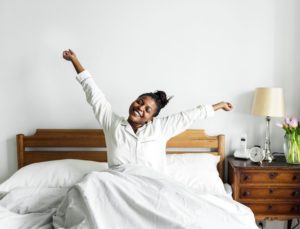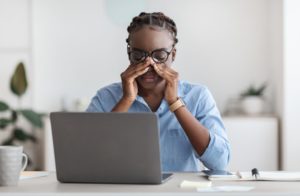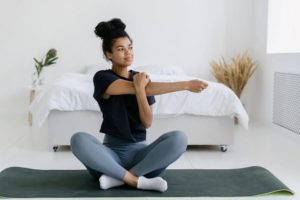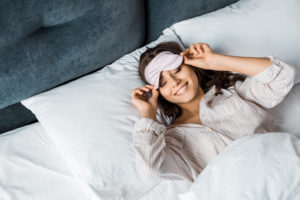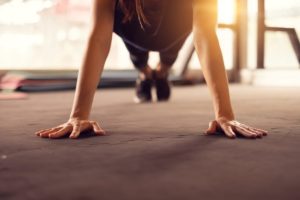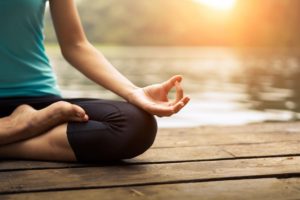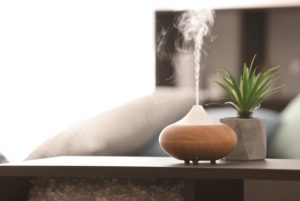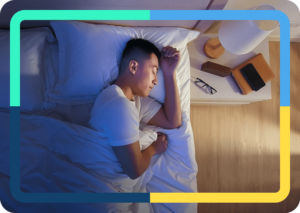Relaxation Exercises To Help Fall Asleep
Having trouble falling asleep is a common experience. In fact, research suggests that almost a third of adults experience chronic insomnia, or persistent difficulties in falling or staying asleep. However, for those of us without insomnia, tossing and turning in bed after a stressful day can be a familiar experience.
Stress and anxiety are often to blame for sleep issues. When our body’s stress response is activated, it can be immensely challenging to fall and stay asleep. Fortunately, research has shown that we can turn off the stress response by activating another natural process, called the relaxation response, and help ourselves drift off to sleep naturally.
Are You Getting Enough Deep Sleep?
A variety of issues can cause degrade your sleep quality. Answer three questions to understand if it’s a concern you should worry about.
Breathing Exercises
Taking slow, deep breaths is one of the easiest and most basic ways to engage your body’s natural relaxation response. Taking 10 deep breaths alone can begin to slow your breath and create a sense of calm. If you’re looking for other breathing exercises, here are a few to try.
Diaphragmatic Breathing
Diaphragmatic breathing (also called belly breathing) engages the large muscle at the base of the lungs. Not only can this exercise reduce stress and increase relaxation, it can also strengthen the diaphragm and increase the efficiency of our breathing. Here’s how to try diaphragmatic breathing:
- While lying down, place one hand on your upper chest and the other hand at the top of your belly, right below your rib cage.
- Breathe in through the nose so your belly pushes against your hand. Your other hand and your chest should remain as still as possible.
- While continuing to keep your chest still, tighten your stomach muscles and exhale.
- Repeat this process.
Because many of us aren’t used to engaging our diaphragm when we breathe, this exercise may take some practice. Try starting with just a few minutes of diaphragmatic breathing when you get into bed, then gradually increase the time to maximize benefits.
4-7-8 Breathing
This slightly more advanced breathing technique helps control the speed of your breath. This may not be the best option if you’re uncomfortable holding your breath, but it’s generally considered safe and easy. Here’s how it works:
- Inhale through your nose for 4 seconds.
- Hold your breath for a count of 7 seconds.
- Exhale through your mouth for 8 seconds, allowing your exhale to make a natural sound like you’re blowing out a candle.
Just like other breathing exercises, start with practicing this technique for a few minutes before bed. As you get used to the pace, feel free to increase the time you spend practicing 4-7-8 breathing.
Visualization Exercises
Another way to engage the body’s natural relaxation response is to use visualization exercises. These techniques rely on using mental images to create a sense of well-being in the body, which can reduce stress and help you fall asleep.
Body Scan
Body scans are a type of meditation that feature a slow, focused attention to different parts of the body. Once you’re lying comfortably in bed, try these steps for a relaxing body scan:
- Start by taking a few deep breaths to get your body into a relaxed state.
- Bring your attention to your feet, noticing any sensations in your toes and if you’re holding any tension in this part of the body.
- Acknowledge any discomfort and try to let go of it. Visualize the tension leaving the body through the breath.
- When you’re ready, move your focus to your calf muscles, repeating the process of noticing sensations, and visualizing the tension leaving through your breath.
- Methodically move your attention to each part of your body, one-by one, moving from your feet to your forehead until you’ve scanned your entire body.
Yoga Nidra
Yoga nidra is a form of meditative yoga intended to induce calmness, which may lead to improved sleep. In practice, the technique of yoga nidra relies on mental imagery while lying on one’s back. You may try yoga nidra with an instructor or through audio or video recordings online.
Yoga nidra often involves the following steps:
- Lie flat on your back with your hands apart.
- Think of a short, positive phrase or mantra.
- Increase your body awareness by mentally visualizing different parts of the body in succession.
- Focus on each breath and imagine the air flowing in and out of the body.
- Recall personal experiences, feelings, and sensations, both good and bad.
- Visualize each specific scene and emotion as if happening in the present moment.
- Repeat the earlier positive phrase and return awareness to the body and room you are in.
- Continue the process until you’ve reached a deep state of relaxation.

Progressive Muscle Relaxation
Progressive muscle relaxation is based on the idea that it’s hard to be tense when your muscles are relaxed. This exercise is performed by methodically tensing and relaxing different muscle groups, one by one.
You can write down all of the muscle groups or make an audio recording of yourself saying each one, giving about 30 seconds in between each group. Although you can customize the groups to your preference, they may be categorized into:
- Toes and feet
- Legs and thighs
- Hips and buttocks
- Stomach and back
- Hands, wrists, and forearms
- Biceps, shoulders, and chest
- Front and back of the neck
- Mouth, cheeks, and jaw
- Eyes, nose, and forehead
Once you’re ready, lie down in bed and try the technique:
- Breathe in and tense the first group of muscles for 5-10 seconds.
- Breathe out and quickly relax the muscles in that group.
- Stay relaxed for 10-20 seconds before moving to the next muscle group. Continue until all muscle groups have been acknowledged.
Non-Sleep Deep Rest
Non-sleep deep rest (NSDR) is a practice that focuses a conscious mind into a state of calm. Similar to self-hypnosis, NSDR can be done on your own or through a recorded guide. Although still awake, the moment of deep rest can help your body restore its energy and may also help increase brain neuroplasticity and memory.
The goal of NSDR is controlled relaxation without letting your body slip into the first stage of sleep. While the technique isn’t meant to induce sleep, NSDR can be used as a type of meditation for sleep and may help you get into the highly relaxed state that occurs just before sleep.
Here’s how to begin:
- Get yourself comfortable and lie in bed with your eyes closed.
- Focus on your body and think about your muscles relaxing.
- Begin inhaling through your nose and exhaling slowly through your mouth.
- Imagine sinking deeper into the surface you’re laying on as you become more relaxed.
- Stay focused and avoid letting your mind wander to any thought other than resting.
Our Advice When Trying Relaxation Exercises
These exercises will be more effective when combined with other improvements to your sleep hygiene, such as maintaining a consistent sleep schedule and cultivating daytime habits that promote sleep. Before you try relaxation exercises to help you fall asleep, here are some helpful tips to keep in mind.
- Relaxation exercises take practice: Repetitive and ongoing use of relaxation exercises is usually more effective than one-time or short-term use.
- Find what works for you: This may take some experimenting, so if one exercise doesn’t work, just try another.
- Try relaxing out of bed: If you cannot fall back asleep after 15 minutes of in-bed relaxation techniques, try a relaxing activity elsewhere and avoid associating your bed with frustration.
- Ensure your room is ideal: A quiet, dark, and comfortably cool sleep environment free of distractions is essential to avoiding sleep disruptions.
- Choose appropriate bedtime snacks: A balanced diet during the day can help promote sleep at night, while things like caffeine, nicotine, and alcohol before bed can upset your sleep cycle.
While these exercises are safe for most people, others may benefit from talking to their doctors before trying these techniques. This is particularly important for those with epilepsy, psychiatric conditions, or a history of trauma.

Still have questions? Ask our community!
Join our Sleep Care Community — a trusted hub of sleep health professionals, product specialists, and people just like you. Whether you need expert sleep advice for your insomnia or you’re searching for the perfect mattress, we’ve got you covered. Get personalized guidance from the experts who know sleep best.
References
3 Sources
-
Sharpe, E., Lacombe, A., Butler, M. P., Hanes, D., & Bradley, R. (2021). A closer look at yoga nidra: Sleep lab protocol. International Journal of Yoga Therapy, 31(1), Article_20.
https://pubmed.ncbi.nlm.nih.gov/33175980/ -
Toussaint, L., Nguyen, Q. A., Roettger, C., Dixon, K., Offenbächer, M., Kohls, N., Hirsch, J., & Sirois, F. (2021). Effectiveness of progressive muscle relaxation, deep breathing, and guided imagery in promoting psychological and physiological states of relaxation. Evidence-based Complementary and Alternative Medicine, 5924040. Retrieved August 3, 2022, from
https://pubmed.ncbi.nlm.nih.gov/34306146/ -
Fujino, M., Ueda, Y., Mizuhara, H. et al. Open monitoring meditation reduces the involvement of brain regions related to memory function. Sci Rep 8, 9968 (2018).
https://doi.org/10.1038/s41598-018-28274-4

















